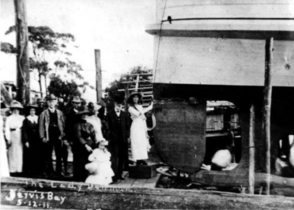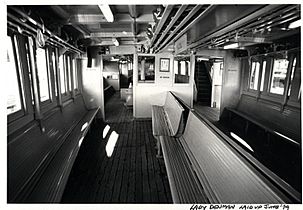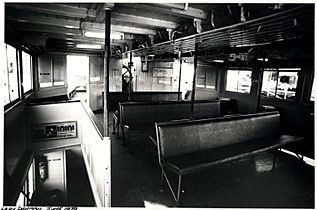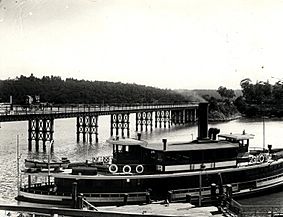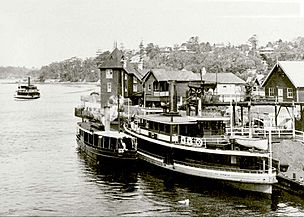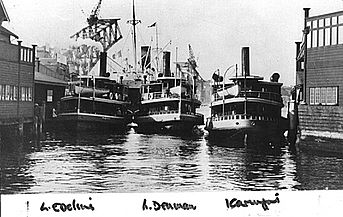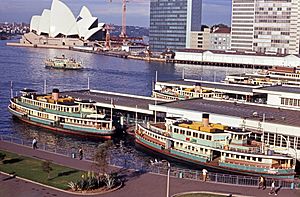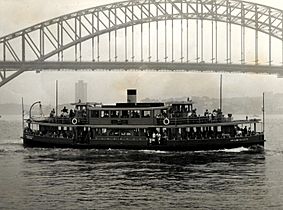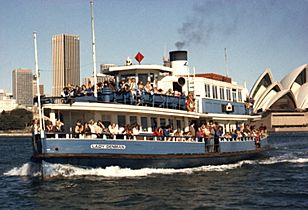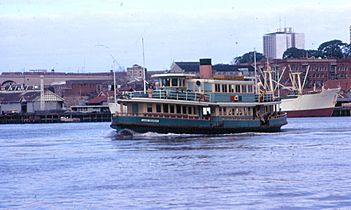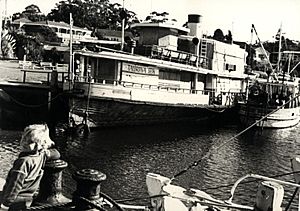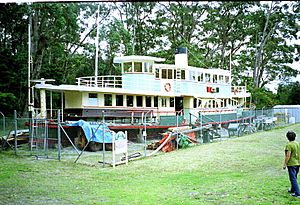MV Lady Denman facts for kids
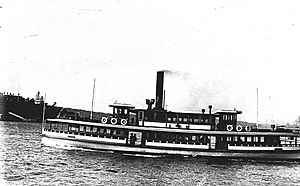
As a steamer, 1920s
|
|
Quick facts for kids History |
|
|---|---|
| Name | Lady Denman |
| Operator | Balmain New Ferry Company, Sydney Ferries Ltd, Sydney Harbour Transport Board, Public Transport Commission |
| Builder | Joseph Dent, Huskisson |
| Launched | 5 December 1911 |
| Completed | 1912 |
| Out of service | 1979 |
| Fate | donated for preservation |
| General characteristics | |
| Tonnage | 96 tons |
| Length | 33.7 m |
| Beam | 7.6 m |
| Decks | 2 |
| Propulsion | 38 hp compound steam, diesel (from 1936) |
| Speed | 11 knots as built, 9 knots as diesel |
| Capacity | 500 passengers |
The Lady Denman is a famous old ferry from Sydney Harbour in Australia. She was built in 1912 and used to carry passengers for the Balmain New Ferry Company. Later, she was operated by other government ferry companies.
Today, the Lady Denman is kept safe at the Jervis Bay Maritime Museum. This museum is very close to where she was first built in Huskisson. She is special because she is the very last wooden ferry of her kind that was "double-ended." This means she could travel forwards or backwards without turning around.
The Lady Denman was one of five similar ferries, all called "Lady-class" ferries. They were designed by a famous ship architect named Walter Reeks. Even after the Sydney Harbour Bridge opened in 1932, which meant fewer people needed ferries, the Lady Denman and her sisters kept working. They were even changed from steam power to diesel engines. The Lady Denman stopped working as a ferry in 1979 and was given to the museum to be preserved.
The ferry was named after Gertrude Denman. She was the wife of the fifth Governor-General of Australia. Many ferries from the Balmain Ferry Company were named after the wives of important leaders.
Contents
How the Lady Denman Was Designed and Built
The Lady Denman and her four sister ferries were made of wood. They were "double-ended" and used a single propeller. This propeller could push the boat in one direction and pull it in the other. This special design was created by Walter Reeks. It made the ferry simpler and put less stress on the wooden hull.
The hull of the Lady Denman was built by Joseph Dent Limited. They used local timber from their sawmill in Huskisson. Her keel, which is the backbone of the ship, was made from a huge 96-foot spotted gum tree. This tree was moved by two teams of bullocks!
The hull was launched into the water on December 5, 1911. Then, it was floated to Sydney with timber inside to help it balance. The engines and upper parts of the ferry were finished in Sydney.
The Lady Denman is about 33.6 meters (110 feet) long and 7.6 meters (25 feet) wide. She has two decks for passengers. There are two wheelhouses on the upper deck, where the captain steers the boat. The main deck used to have a special room just for women.
These ferries were built to last only about fifteen years. This was because people thought the Sydney Harbour Bridge would reduce the need for ferries. But the Lady Denman actually worked for 67 years! Because they were meant for a short life, they were built simply. For example, their roof was made of galvanized iron. They were also small and had a shallow bottom to travel in the muddy parts of the rivers.
Her first engines were steam-powered and could make her go about 10 knots (about 18.5 kilometers per hour).
-
Launch day, Huskisson, 5 December 1911
Early Years (1912-1932)
Around 1900, the Balmain New Ferry Company grew bigger. They wanted to keep up with the expanding tram network in Sydney. They sold older ferries and brought in new "Lady-class" ferries.
The Lady Denman was the second of five ferries in the company's last series of "Lady-class" boats. These ferries were used on the Lane Cove River service. They also traveled from Balmain to the Erskine Street wharf.
In 1918, Sydney Ferries Limited bought the Balmain company, including the Lady Denman and her sisters. These five ferries continued to run services on the Lane Cove River. Later, they worked on the Parramatta River and other routes around the harbour.
-
At Fig Tree depot on the Lane Cove River, 1925
-
With Lady Edeline and Karingal at Circular Quay as the Sydney Harbour Bridge nears completion, 1930
Life After the Sydney Harbour Bridge (1932-1979)
When the Sydney Harbour Bridge opened in 1932, fewer people needed to take ferries. Sydney Ferries Limited's passenger numbers dropped a lot. To save money, many older and larger steam ferries were sold. However, the five "Lady-class" ferries were kept.
In the 1930s, these ferries were changed to use diesel power instead of steam. Their tall smoke stacks were replaced with shorter funnels. In 1936, the Lady Denman started service again with a new diesel engine. The "Lady" ferries continued to run services to Hunters Hill and Balmain.
During the Great Depression and World War II, many people couldn't afford their own transport. Also, fuel for cars was rationed. This meant that ferries, especially the ones using coal, were still important. The Lady Denman and her sisters even carried people to Cockatoo Island during World War II.
After World War II, fewer people used ferries again. In 1951, the NSW State Government took over Sydney Ferries Limited. Most of the large wooden steam ferries were taken out of service. But the smaller, more efficient "Lady-class" ferries were kept. They became the main ferries for inner-harbour routes. These routes included places like Taronga Park Zoo, Milsons Point, and Cremorne.
Most of the sister ferries had their engines replaced again in the late 1950s and early 1960s. The Lady Denman received a new, more powerful diesel engine. On August 29, 1965, she even ran aground near Shark Island. Luckily, everyone was safe!
-
in her Public Transport Commission colours headed for Taronga Zoo, 1975
What She Looked Like: Her Colours
When the Lady Denman was first built, she was painted white and maroon. She had a black funnel and shiny wooden parts.
After she was changed to diesel power in 1936, she and the other ferries were painted yellow and green with red trim. This was a new look for the ferries after the Harbour Bridge opened.
In the 1960s, the NSW government changed the ferries' colours again. They became a more muted cream and khaki. In the 1970s, the ferries were painted blue and white.
Retirement and Preservation
The Lady Denman stopped working as a ferry in 1979. Her last trip was on June 14, 1979.
Of her five sister ferries, only the Lady Denman still exists today. The others were sold, rebuilt, or scrapped over the years. For example, Lady Chelmsford was sold and used as a show boat, but later sank. Lady Ferguson was towed to Hobart to help after a bridge collapse, but she was in too bad condition and was scrapped.
A group from Huskisson wanted to save the Lady Denman. They convinced the Public Transport Commission to donate her to a museum in Huskisson. She was towed out of Sydney Harbour in 1980, but rough seas damaged her, and she had to turn back.
A second attempt to tow her was made in 1981. This time, she ran into a storm near Wollongong and started taking on water. The Royal Australian Navy helped protect the ferry, and the tow was completed to Jervis Bay. She almost sank right where she was built in Currambene Creek!
On April 3, 1983, the Lady Denman was finally pulled ashore. She was placed very close to where she was originally built. Restoration work began to fix her up. With a grant from the government, the Lady Denman Maritime Museum (now called Jervis Bay Maritime Museum) opened in 1988.
A special dry dock was built, and a channel was dug to where the ferry was sitting. The dock was flooded, and the Lady Denman was floated and pulled by volunteers to her new spot. Then the water was drained, and a building was constructed around her in 1998 to protect her. Work continues to make her look like she did in the 1960s.
The Lady Denman was added to the New South Wales State Heritage Register in 2001. This means she is recognized as a very important part of history. Her condition is good because of all the conservation work. Her engines have been removed and are displayed separately.
Why the Lady Denman is Important
| MV Lady Denman | |
|---|---|
| Lua error in Module:Location_map at line 420: attempt to index field 'wikibase' (a nil value). | |
| Location | Dent Street, Huskisson, City of Shoalhaven, New South Wales, Australia |
| Built | 1911–1912 |
| Architect | Walter Reeks |
| Owner | Lady Denman Heritage Complex Huskisson Inc. |
| Official name: Lady Denman (M.V.); Sydney ferry; M.V. "Lady Denman" | |
| Type | state heritage (movable / collection) |
| Designated | 9 November 2001 |
| Reference no. | 1518 |
| Type | Vessel - harbour & river |
| Category | Transport - Water |
| Builders | Joseph Dent |
The Lady Denman is listed on the New South Wales State Heritage Register because she is very important to history.
- She is a rare example of the type of ferry that served Sydney Harbour for over a century.
- She worked for 67 years and is strongly linked to the image of Sydney as a harbour city.
- She is one of only two traditional wooden ferries left from Sydney's inner harbour.
- She is a rare example of the designs by Walter Reeks, a very creative Australian naval architect.
- She is the last ferry built in Huskisson that still exists. This shows the importance of Huskisson as a shipbuilding place.
- She is the only Sydney Harbour ferry that has been returned to the place where she was built.
- She helps us understand how boats were built using local timber.
- She represents the "Lady-class" ferries and the wooden ferries of Sydney Harbour.


